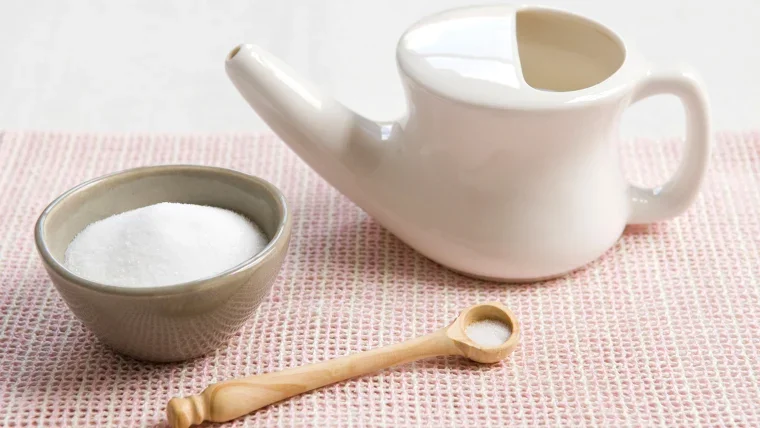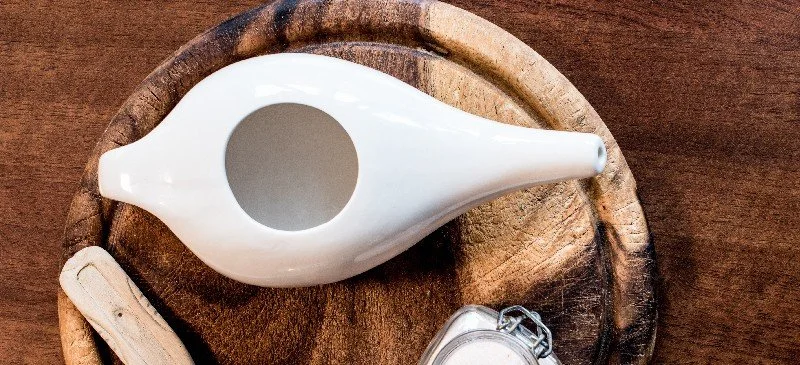Nasal Irrigation
Medicinal Profile of
Nasal Irrigation
Nasal irrigation involves flushing the nasal passages with a saline solution to clear mucus, allergens, and irritants. Traditionally practiced in Ayurveda as jala neti and adopted worldwide through neti pots, squeeze bottles, and saline sprays, it is valued for maintaining respiratory hygiene. From a terrain perspective, nasal irrigation helps reduce excess fluids, stagnation, and irritation in the upper respiratory tract, while supporting mucosal balance and defense.
-
Nasal irrigation has roots in traditional Ayurvedic practice (jala neti) and has been adapted worldwide into modern methods such as neti pots, squeeze bottles, and saline sprays. It was originally valued for spiritual and physical purification, but is now widely recognized for its role in sinus hygiene, allergy relief, and respiratory health.
-
👉 Qualities describe the felt nature of a substance or practice, and how it acts in the body beyond nutrients or chemistry.
Immediate Qualities (Short-Term Effects)
Clearing – Flushes out allergens, pollutants, and thick mucus.
Stabilizing – Reduces irritation and reactivity of nasal tissues.
Moistening – Restores lubrication to dry nasal passages.
Long-Term Qualities (With Regular or Excessive Use)
Drying (in sensitive terrains) – Overuse can strip natural moisture, leading to rebound dryness.
Irritating (if solution too strong or contaminated) – May provoke inflammation, stinging, or infection if improperly prepared.
-
👉 Terrain patterns describe the body’s functional state, showing when a practice is most helpful or aggravating, while affinities identify the organ systems where its actions are most directly felt.
👉 If you want to learn more about the terrain patterns, please check out this educational post.
Primary Indicated Terrain Pattern:
Fluid Congestion & Stagnation – When mucus and dampness accumulate, leading to heaviness and obstruction.
Respiratory System (Affinity) – Clears sinuses, reduces congestion.
Immune System (Affinity) – Helps reduce pathogen and allergen burden.
Nervous System (indirect) – Relieves congestion-related headaches and supports restful sleep.
Warranted Method – Neti pot or squeeze bottle with warm isotonic saline.
Dose – 1–2 times daily during acute congestion; reduce to occasional use once clear.
Secondary Indicated Terrain Patterns:
Heat/Excitation – Calms irritation, burning, or reactivity in inflamed sinus passages.
Respiratory System (Affinity) – Soothes inflamed mucosa, reduces allergy flare.
Warranted Method – Isotonic saline irrigation or mist.
Dose – 1x daily or every other day during allergy season.
Caution – Avoid if active nosebleeds are present.
2. Dry/Atrophy – Saline mist (not full irrigation) may soothe dryness and fragility in nasal mucosa.
Warranted Method – Saline spray or mist only (not full irrigation).
Dose – 2–4 sprays per nostril as needed, up to several times daily.
-
Neti Pot – Warm saline flows gently by gravity through one nostril and out the other.
Squeeze Bottle / Bulb Syringe – Provides controlled pressure for deeper clearing.
Saline Mist / Spray – Portable, gentle, best for dryness or light irritation.
Solution Guidelines – Use sterile, distilled, or previously boiled water with isotonic (~0.9% saline) or mild hypertonic solutions.
-
👉 Medicinal actions describe the specific ways a practice influences organ systems and body functions.
Respiratory Support – Clears mucus, allergens, and pollutants to ease breathing.
Anti-Irritant – Reduces nasal tissue reactivity to allergens and pollutants.
Hydrating – Moistens dry mucosa and restores lubrication.
Cleansing / Detoxifying (local) – Mechanically flushes debris and reduces microbial load in the sinuses.
-
Mechanical Clearance – Saline solution physically washes away mucus, allergens, and irritants.
Osmotic Effect – Isotonic saline maintains fluid balance, while mild hypertonic solutions help draw out excess fluid from swollen tissues.
Mucociliary Function – Regular irrigation supports ciliary motion, improving the natural “self-cleaning” ability of the nasal passages.
Barrier Protection – Hydration of mucosa helps preserve integrity, making tissues less susceptible to infection and irritation.
-
Moderate – Effective for prevention, maintenance, and mild-to-moderate symptom relief (allergies, congestion, sinus irritation). Not sufficient alone for severe or systemic infection.
-
Decongestant Sprays (oxymetazoline, phenylephrine) – May compound dryness and irritation if used together with frequent irrigation.
Antihistamines (oral or nasal) – Can dry tissues; irrigation may help counteract this effect.
Herbal Steams – Can be complementary if used before irrigation to loosen mucus (but herbs should not be added directly to irrigation solution).
Essential Oils – Contraindicated in irrigation due to mucosal irritation risk, but can be used in adjacent inhalation practices.
-
Water Source – Only use sterile, distilled, or previously boiled water to prevent rare but serious infections (e.g., Naegleria fowleri).
Solution Strength – Isotonic (~0.9% saline) is safest; hypertonic (1.5–3%) can reduce swelling but may sting.
Active Bleeding – Contraindicated in ongoing nosebleeds or extreme vascular fragility.
Overuse – Chronic daily irrigation may strip natural mucosal defenses, causing rebound dryness.
Children – Mist or drops are safer than full irrigation for young children.
-
Rabago, D., Zgierska, A. (2009). Saline nasal irrigation for upper respiratory conditions. American Family Physician, 80(10), 1117–1119.
Harvey, R., Hannan, S. A., Badia, L., Scadding, G. (2007). Nasal saline irrigations for the symptoms of chronic rhinosinusitis. Cochrane Database of Systematic Reviews, (3), CD006394.
Heatley, D. G., McConnell, K. E., Kille, T. L., Leverson, G. E. (2001). Nasal irrigation for the alleviation of sinonasal symptoms. Otolaryngology–Head and Neck Surgery, 125(1), 44–48.
Tomooka, L. T., Murphy, C., Davidson, T. M. (2000). Clinical study and literature review of nasal irrigation. Laryngoscope, 110(7), 1189–1193.
Shoseyov, D., Bibi, H., Shai, P., Shoseyov, N., Shazberg, G., Hurvitz, H. (1998). Treatment with hypertonic saline versus normal saline nasal wash of pediatric chronic sinusitis. Journal of Allergy and Clinical Immunology, 101(5), 602–605.
Stjarne, P., Blomgren, K., Cayé-Thomasen, P., Soderstrom, M., Stoksted, P. (2009). The use of nasal irrigation after sinonasal surgery: a Nordic survey. Acta Oto-Laryngologica, 129(10), 1115–1120.
Tichenor, W. S. (2003). Contaminated nasal irrigations — a potential source for infection. Annals of Allergy, Asthma & Immunology, 91(1), 56–59.
Singh, S., Nagpal, R. (2009). Jala Neti: A yogic practice for nasal health. International Journal of Yoga, 2(1), 15–18.



